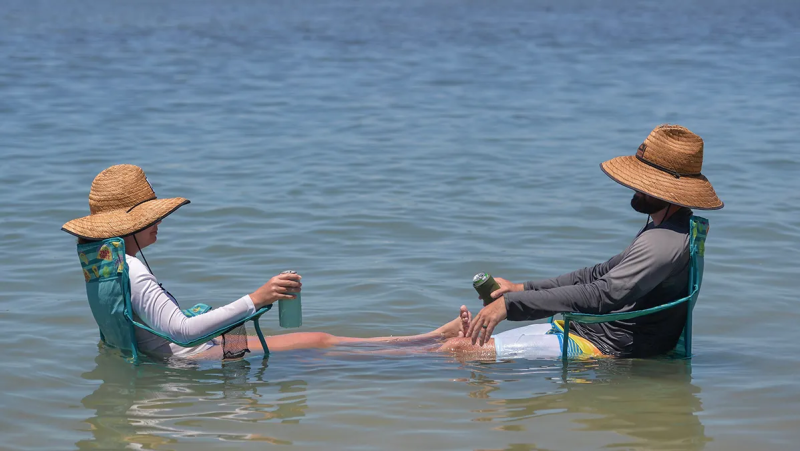Students are sweating through class without air conditioning. Districts are facing the heat.
Students in Mindy Neiland's elementary school complained of headaches, nausea and nosebleeds this week as a potentially record-breaking heat wave struck the West Coast and baked schoolrooms from Los Angeles to Las Vegas.
On Thursday after lunch, Neiland walked over to the thermostat in her Granada Hills, California, classroom to check the temperature and saw the scorching number: 94 degrees.
The air conditioning doesn't work and she said the portable cooling machine the district gave her as a backup is "useless" because it blows hot air.
"My students have headaches, they're miserable and they cannot learn in this environment," she said.
Los Angeles Unified is among many districts nationwide scrambling to fix or install cooling systems and shade structures on campuses as climate change and extreme heat settle into improperly equipped classrooms, gymnasiums and playgrounds.
The extreme summer weather illuminates a pressing expenditure for school budgets and a point of growing tensions between school communities and officials: cooling systems and shade structures.
Many schools have survived for years without the AC, but that is no longer their reality. Regions across the U.S. that never had the need now face mounting pressure to update facilities to keep kids cool. This summer was the Earth's hottest, topping last year's record, according to the Copernicus Climate Change Service.
The need to cool schools has increased markedly in the Upper Northwest and in states such as California, Alaska and Montana, according to a recent analysis by Climate Central which measures cooling demand from late July to early September.
Hotter days around the start of the academic year will affect classroom and campus temperatures and threaten student learning more frequently, said Cassandra Davis, a professor of public policy at the University of North Carolina at Chapel Hill.
"Soaring temperatures put a strain on already aging facilities that public schools have," Davis said. "And in places that are not likely to have up-to-date AC units, it's no surprise that learning is stopped, halted or postponed."
Hundreds of poorly equipped schools facing late summer heat, including some in Philadelphia, Pittsburgh, Pennslyvania, and Portland, Oregon, sent kids home early in September due to excessive heat warnings.
The abbreviated instruction time impairs student learning and further exacerbates the achievement gap, Davis said.

Why don't schools have adequate air conditioning?
Many classrooms and school gymnasiums are too hot without air conditioning in the summer months. But that didn't used to be the case. In regions of the country that are new to scorching temperatures, some buildings are not equipped with cooling systems.
There are also challenges in regions where it always gets sweltering hot. In areas with cooling systems, districts must contend during heat waves with aging and broken facilities. The urgency of these repairs is being shouldered by maintenance workers, including those in Los Angeles who have been responding to daily requests to fix air conditioning systems this school year.
A total of 50,000 AC units in the district need to be replaced because they are old, deteriorated or malfunctioning, said Britt Vaughn, a spokesperson for the Los Angeles Unified School District.
Officials coordinating fixes to these cooling systems are offering teachers alternative indoor cooling units and they're placing misting fans at elementary schools to help keep exterior student dining areas cool during hotter days, Vaughn said.
In Reno, Nevada, where the number of days AC is needed has increased according to Climate Central's analysis, some school gymnasiums built in the 1980s lack cooling systems, which weren't considered a necessity at the time, said Adam Searcy, chief operating officer of the Washoe County School District.
Some of these Reno gyms now reach up to 80 degrees during volleyball practices in the early summer months, however, the district has no plans to install air conditioning because it's too costly, Searcy said. He said district schools do, however, plan to build future gyms with proper cooling systems.
"The rise in cooling demand will likely continue as the planet warms, and schools will need critical building upgrades and face higher operating costs to maintain safe, comfortable temperatures," according to the Climate Central report.

How heat affects students and teachers
All students feel the negative academic impact of hot classrooms because kids can't learn in unhealthy weather conditions, Davis said.
Traditionally disadvantaged students will feel it even more in low-income communities with less access to air conditioning and shaded areas since "there isn't the ability to play outside and come inside to cool off," which is vital for student wellbeing, she said.
"We know historically that communities of color and low-income communities are in places that are less likely to have tree coverings," Davis said. "They’re located in environmentally hazardous spaces without access to shade."
Are there solutions?
Some regions have made major headway in addressing the shortfall. Chicago schools' classrooms have air conditioning units, but that wasn't always the case.
Years ago, the Chicago Teachers Union negotiated with the district to ensure classrooms were cool, Stacy Davis Gates, president of the teacher's union, told USA Today. The group is now focused on pushing the district toward additional energy-saving solutions.
"The doesn’t just mean AC in the unit but also ... solar panels on the roof to build the cost down," she said.
Some regions are shifting the school calendar year to make it easier for kids. Milwaukee Public Schools pushed back its academic calendar this year to start in early September rather than late August. This choice happened after the district was forced to cancel classes due to excessive heat in the early days of the last school year.
Other jurisdictions have passed laws or considered regulations requiring schools to keep classrooms cooled to a certain temperature.
A workers' rights law passed in California in July requires districts to keep schools at a comfortable temperature. However, some schools in the Golden State say they're struggling to keep up with that mandate.
Contact Kayla Jimenez at kjimenez@usatoday.com. Follow her on X at @kaylajjimenez.
Disclaimer: The copyright of this article belongs to the original author. Reposting this article is solely for the purpose of information dissemination and does not constitute any investment advice. If there is any infringement, please contact us immediately. We will make corrections or deletions as necessary. Thank you.





